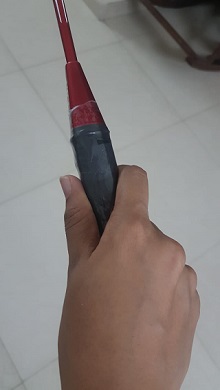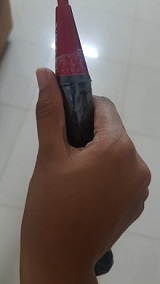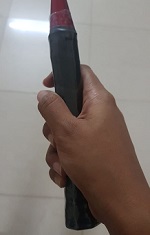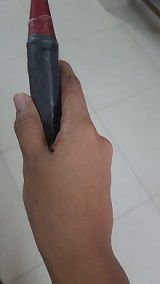The game of badminton is built on several techniques. The first and foremost technique is the grip while holding a badminton racquet. Ask yourself before entering the badminton court whether you are holding the grip properly. Well, a proper grip is essential to develop and improve all types of strokes in badminton.
Many times, players get carried away with the game and forget the most essential thing – a good badminton grip. This results in poor performance and making multiple mistakes during the game.
A good badminton grip helps in effective wrist movement during your game. It can help to reduce injuries, increase the range of shots, and produce more efficient hits.
Most of the badminton shots rely on your wrist technique, therefore, it is very important to grip your racquet correctly. When you grip your racquet in the wrong manner, some of your movements can be restricted which can affect your game. It can limit the range of strokes in a dynamic badminton game.
Hence, grip your racquet correctly so that you can correctly learn badminton and enhance your performance. It will also boost your confidence while you grow in the game.
A simple and correct way of holding your racquet is as easy as a ‘friendly handshake’. Imagine the grip of your racquet as someone approaching you to shake your hand. Go ahead and hold the racquet as if you are shaking that person’s hand.
Your thumb must rest against the wider surface of the grip while the rest of your hand holds the racquet as if shaking a person’s hand.
Few things to remember while you hold the racquet:
Do not hold your racquet tightly. You have to keep changing your grip during a game. If your hold it tightly, it will affect the flexibility of your wrist. This will not allow you to change your grip on time.
Use only your thumb, index, and middle finger to control your racquet. Your last two fingers must rest on the grip to balance the racquet. This will increase the flexibility of your wrist.
Also read: Badminton Grips: Types and Criteria for selection
Grip Techniques In Badminton
In this article, I will introduce you to the different types of grips and how to make the best use of them in badminton. Let us dive into a clear and simple explanation of the angles and position while holding different types of grips.
Forehand Badminton Grip
This is the basic grip in badminton. It is used to hit forehand shots.
Start with holding the racquet using a ‘handshake grip’. Do not hold tightly. You should be able to move and twist the racquet with flexible wrist movement.

In this grip, your thumb does not have to necessarily press against the wider surface of the grip. This is because the index finger is the one that controls the racquet in this grip. Your index finger will help to push the racquet forward while doing a forehand stroke. However, rest your thumb comfortably on the wider surface so that you can change the grip easily.
Only when you are about to strike the shuttle, hold it tightly. This grip is used in all forehand and overhead shots. A good guideline for the grip is to form a ‘V-shape‘ between the thumb and index finger, and the lowest section of the V should align with the head of your racquet.
Make sure the index finger is curled around the handle and not straight under any circumstances.
It is very essential to master this grip as it will be your first-hand support in the game. Remember to always keep it easy and relaxed. Master the forehand technique to move ahead with the backhand technique.
A forehand and backhand grip is almost the same, the only slight difference being the placement of your fingers.
Backhand Badminton Grip
It is used for making shots that are on the non-racquet side of the body. A good backhand shot depends on how you hold your racquet. The true power of a backhand shot comes from the push of your thumb.

A backhand grip required you to use your thumb. Therefore, you need to rest your thumb a bit tight on the wider surface of the grip. This will make you hit the shot easily across the court. Relax the index finger moving it closer to the middle finger.
Remember, clench loosely on the handle and tighten only when you hit the shot. This grip requires a lot of practice but is very essential for the overall development of the game.
Backhands are usually a limitation for most of the players. Therefore, keep practicing and convert this limitation into an advantage.
Backhand Bevel Thumb Badminton Grip

Unlike the backhand grip, bevel grip is more for applying deceptive and defensive shots. In this, place your thumb on the small edge of your grip, not on the entire wide surface. It is used when you have control over the shots and you want to smoothly return the shuttle.
It is combined with loose fingers. However, there should a gap between the index and middle finger. The movement takes place with the help of the thumb and index finger. It is used for low serves and closer to the net shots, usually in doubles.
Hammer Grip

This grip is used when you are executing a normal or a jump smash. It is named hammer because you have to hold the grip like you are holding a hammer.
Start with a normal forehand grip and then rotate the grip swiftly into a hammer grip and clench it tightly while hitting the smash.
Net Tap Grip/Pan Hold Grip

This kind of gripping is needed in the frontcourt near the net when the shuttle is returned very close to the net. At the very right moment, before the shuttle starts to descend, you need to tap the shuttle to take advantage of such a return.
You will require your thumb, index finger, and middle finger to do the tap. Gently hold the racquet with your thumb and fingers creating space between the racquet handle and your palm.
Do not allow your thumb to cover any of your fingers as this would constraint the movement of the racquet. This grip would allow very little movement or no movement at all.
Changing Grip More Quickly
You need to keep changing your grip for different shots. This is because of the position of your body and the position you are taking the shuttle.
Therefore, you must learn how to change quickly from your forehand to backhand grip and vice versa. This enables you to be prepared and hit the shuttle from the highest point. While you keep practicing, you will find yourself changing the grips without even thinking.
Keep practicing while you are sitting idle at home. This sounds crazy but it is very helpful.
Always remember, finger action plays an important role in generating strength for a badminton stroke.
- For forehand strokes, push your index finger forward.
- For backhand strokes, push your thumb forward.
Incorrect Grip
- Your thumb should not cover any of your fingers. This will restrict the movement of the racquet.
- Never extend your index finger. This can lead to injury. Keep it bend and wrapped around the racquet comfortably.
- Do not place the thumb of your hand on the side of the racquet. You will not be able to hit effectively with this grip.
Final Thoughts
While you grip your racquet, ensure you relax your fingers. This is because relaxed grips make it easy for the muscles in the arm to attain flexibility and mobility. This allows you to change your grips quickly. It also adds more power to your shots with the maximum transfer of energy from your hands to the shuttle.
Also, it is advisable to hold the racquet towards the far end base of the handle. This adds more leverage to your hitting power. It takes less power to make powerful shots from the end of your handle than holding it closer to the innermost part of the handle.
Rely on your ring and little fingers for stability and the other fingers should be used for grip manipulations.
Wall exercising is ready to go flexible exercise you can do anytime and anywhere. Keep practicing it while switching from one grip to another as quickly as you can. You will surely feel a positive change in your grip speed soon. Combine theoretical and practical knowledge while practicing and keep improving your game.
I hope this article was helpful. If so, do share it so that others can find it.
Thanks for reading. Enjoy the game!

